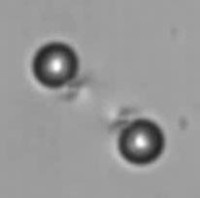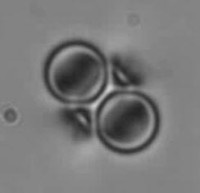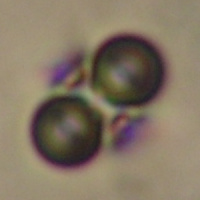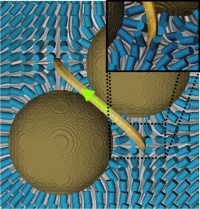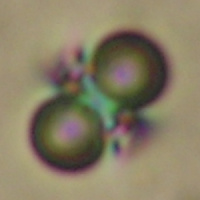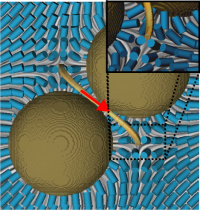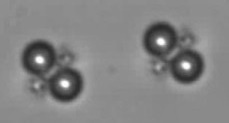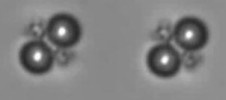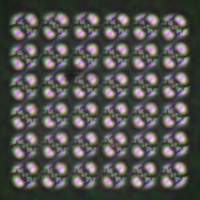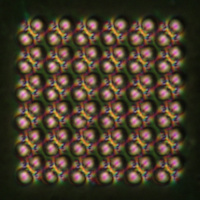Broken mirror symmetry in nematic colloids: chiral dimers and 2D crystals |
When colloidal particles are dispersed in a chiral nematic matrix, such as 90 degrees twisted nematic cell, colloidal self-assembly is substantially different compared to homogeneous nematic. The macroscopic chiral organization of the underlying nematic not only lifts the energy degeneration of recently observed “bubble-gum” colloidal dimers in non-chiral liquid crystal, but also dramatically increases the probability of their formation. We identify experimentally and numerically two basic colloidal dimer conformations in a nematic liquid crystal, that are of opposite chirality and we confirm the non-singular topological nature of their binding. Dimer-dimer interaction weakly depends on the chirality of the dimers and leads to an assembly of 2D nematic colloidal crystals of pure or "mixed" chirality. |
MOVIE: Spontaneous formation of bubble-gum colloidal dimer due to collision of two antiparallel dipolar colloidal particles. | MOVIE: An isotropic droplet formed by the laser tweezers separates the particles. After switching off the light, the particles are attracted by two thin birefringent lines (view under crossed polarizers). |
| When the ring defect between the two particles is perturbed by dragging the high-power tweezers focus along the ring, another colloidal dimer could be created, which is quite similar to the original. However, these two colloidal dimers are clearly different. The difference is in the chirality of dimers, which is due to the mechanism of director escape, illustrated in figures below. |
| 2D colloidal crystals assembled from escaped hyperbolic defect ring colloidal dimers. Left-handed (left) and Right-handed dimers, assembled in Right-handed twisted nematic cell viewed between parallel polarizers. |
TKALEC, Uroš, RAVNIK, Miha, ŽUMER, Slobodan, MUŠEVIČ, Igor.  Vortexlike topological defects in nematic colloids : chiral colloidal dimers and 2D crystals. Phys. rev. lett., 2009, vol. 103, no. 12, 127801-1-127801-4. Vortexlike topological defects in nematic colloids : chiral colloidal dimers and 2D crystals. Phys. rev. lett., 2009, vol. 103, no. 12, 127801-1-127801-4. |

